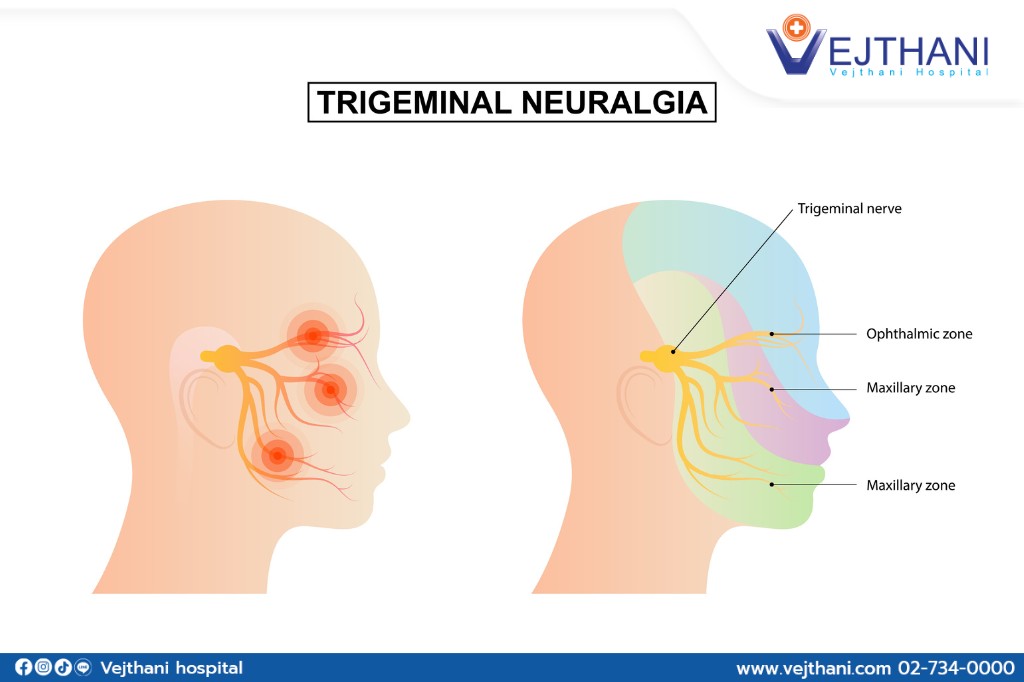
Trigeminal neuralgia


Overview
Trigeminal neuralgia, also referred to as tic douloureux, is a condition characterized by excruciating pain on one side of the face, resembling an electric shock. This chronic pain condition affects the trigeminal nerve, responsible for transmitting sensory information from the face to the brain. Even minor facial stimuli, like brushing teeth or applying makeup, can trigger intense agony in individuals suffering from trigeminal neuralgia. At first, you can encounter brief, mild attacks. However, trigeminal neuralgia can progress and result in longer, more frequent episodes of excruciating pain. Women experience trigeminal neuralgia more frequently than men do, and persons older than 50 are more prone to develop it.
Trigeminal neuralgia frequently affects only one side of the face unilaterally. If it’s bilateral, both sides will be impacted, but not simultaneously. Additionally, bilateral trigeminal neuralgia is very uncommon. It’s interesting to note that this condition typically affects the right side of the face more than the left.
Trigeminal neuralgia is a condition that offers various treatment options, indicating that individuals affected by it are not inevitably condemned to a lifetime of pain. Trigeminal neuralgia is typically successfully treated by doctors using drugs, injections, or surgery.
Types of trigeminal neuralgia
- Typical trigeminal neuralgia (Type 1). Sharp, acute, intermittent pain episodes are probably what you’ll encounter. From a few seconds to two minutes, you can experience pain and/or a burning feeling all over your face. There will be pain–free intervals between attacks, but this can go on for as long as two hours.
- Atypical trigeminal neuralgia (Type 2). This type is less severe and intense, but more ubiquitous. Along with continuous aches and pains, you’ll probably have constant agony, particularly stabbing and/or burning feelings. The symptoms of atypical trigeminal neuralgia could be more challenging to manage.
Symptoms
Trigeminal neuralgia can manifest with one or more of the following symptom patterns:
- Periodic episodes of excruciating, shooting, or stabbing pain that may seem electric shock–like
- Aches and pains brought on by facial spasms
- Periods of no discomfort for some people during multiple attacks that continue for days, weeks, months, or longer.
- Aches in the face, jaw, teeth, gums, or lips that are supplied by the trigeminal nerve, or less frequently in the eye and forehead
- Pain that comes on suddenly or that is brought on by actions like touching the face, chewing, speaking, or brushing teeth.
- Pain attacks can last anywhere between a few seconds and several minutes.
- Pain is infrequently experienced while resting at night
- Increasingly frequent and severe attacks over time
- Unilateral facial pain, impacting only one side at a time
- The pain can be localized to a specific area or radiate in a broader pattern.
Aside from the pain, there may be other symptoms as well.
It is advisable to seek medical attention if you experience facial pain, particularly if the pain is severe, recurring, or unresponsive to over–the–counter pain relievers. Consulting with a doctor is recommended in such cases.
Causes
The trigeminal nerve’s normal function is interfered within trigeminal neuralgia. Typically, the issue is contact between the trigeminal nerve at the base of your brain and a typical blood vessel, in this case an artery or a vein. The nerve becomes malfunction as a result of the pressure this contact puts on it.
While one of the most frequent causes of trigeminal neuralgia is compression by a blood vessel, there are numerous other possible reasons as well. Some of them could be caused by multiple sclerosis or another condition that damages the myelin sheath that shields some nerves. A tumor pressing against the trigeminal nerve might also result in trigeminal neuralgia.
Trigeminal neuralgia may be brought on by a brain tumor or another abnormality in certain persons. Trigeminal neuralgia may also result from facial trauma, stroke, or surgical damages.
Triggers
Trigeminal neuralgia can be brought on by a number of factors, including:
- Talking
- Facial movement such as smiling
- Drinking
- Consuming food
- Brushing your teeth
- Washing or touching your face
- Shaving
- Applying makeup
- Wind blowing on your face























